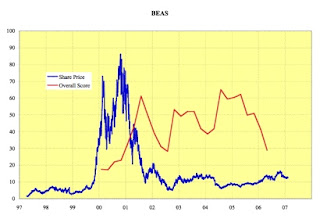
Cisco Systems (CSCO) has a commanding, and highly profitable, position manufacturing and selling the equipment telecoms and other enterprises use to direct the Internet's traffic. After acquiring Linksys and, in February 2006, Scientific Atlanta, Cisco now also sells devices intended for home use.
After a phenomenal rise in 1990s, the price of Cisco Systems stock fell from over $80 in March 2000 to the low teens just over a year later. The price recovered into $20s in 2003, but it then fell back into the upper teens. Finally, last August, the price broke above $20, and Jim Cramer recommended it strongly. It has been in the upper $20s for the last three months.
When we analyzed Cisco after the quarter that ended in October 2006, the Overall score was a weak 24 points. Of the four individual gauges that fed into this overall result, Profitability was the strongest at 11 points. Value was weakest at 2 points.
We have since updated the analysis to incorporate Cisco's financial results for the latest quarter, which was the second of fiscal 2007. With the data available through 27 January 2007, our gauges now display the following scores:
- Cash Management: 9 of 25
- Growth: 14 of 25
- Profitability: 12 of 25
- Value: 1 of 25 (which drives down the overall score)
- Overall: 27 of 100
Growth. This gauge increased 10 points from October. Revenue growth percent a year ago is now 23 percent year over year, up from 10and accelerating. Net Income growth is a vibrant 16 percent, up from 4 percent a year ago. The increase benefited from a change in the income tax rate from 28 to 24 percent. CFO growth is an impressive 26 percent, up from zero growth a year ago. Revenue/Assets is 69 percent; it is down from 77 percent. It suggests that the acquisition of Scientific Atlanta made the company less efficient at generating sales.
Profitability. This gauge increased one point from October. ROIC slipped to a healthy 21 percent. It was 30 percent a year ago. FCF/Equity edged up to 32 percent from 30 percent. Operating Expenses/Revenue percent to 74 moved up in the last year from 71 percent. The change was primarily due to a decline in Gross Margin of 3 percent. The Accrual Ratio, which we like to be both negative and declining, edged down to -5 from -4 percent. This tells us that slightly more of the company's Net Income is due to CFO, rather than changes in balance sheet accruals.
Value. This gauge, based on the stock price of $26.62 on 31 January, dropped to a horrid 1 point, compared to 2 and 12 points 3 and 12 months ago, respectively. The P/E at the end of the quarter was 26, up a little from recent quarters. The increase suggests the shares are becoming more expensive. The average P/E for the industry is 22. To remove the effect of overall market changes on the P/E, we note that the company's current P/E is at a 58 premium to the average P/E, using core operating earnings) for stocks in the S&P 500. This premium is significantly higher than it has been recently, but the premium was this high in the company's past. Companies tend to trade at a premium when their growth rates are greater than average, particularly when the growth rates seem more likely to be sustained. The PEG ratio of 1.62 is indicative of a somewhat expensive stock. The Price/Revenue ratio has increased to 5.2. The increase suggests the shares are becoming (more, less) expensive. The average Price/Sales for the industry is 3.5.
Now at a disappointing 27 out of 100 possible points, the Overall gauge been trending down after an extended period (July 2002 to Jan 2006) above 50 points -- once over 70 points. While the company's operational performance has been strong, the even faster paced increase in the stock price has made Valuation a significant concern.




